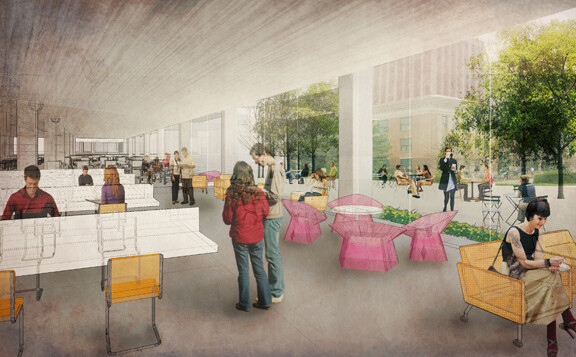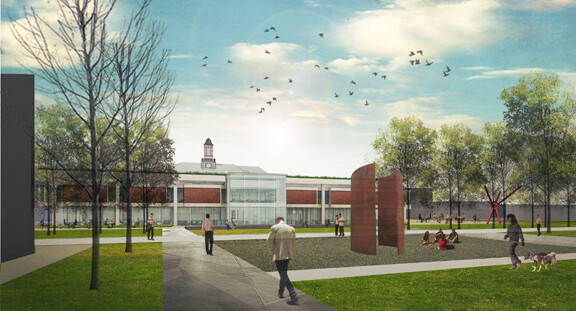
This fall, Nancy Busch, UNL’s dean of university libraries, has been hosting presentations about the Library Commons project.
The initiative aims to transform the first floor of Love Library North into a technology-rich, open academic space where faculty and students can see expert assistance, collaborate on projects and create content.
The University of Nebraska Board of Regents will review the project in January, and construction could start as early as fall 2014.
Plans include adding 520 seats in open areas, 124 seats in 22 study rooms, a digital learning center with 200 computers for online testing and learning modules, and a café. If completed, UNL will join other institutions — including Penn state and the University of Iowa — which have recently converted library space into academic or learning commons.
“We envision the learning commons as an academic space that meets the needs of a 21st century student,” Busch said. “The study rooms will be high tech. There will be commons areas that allow students to work on group projects. Our electronic spaces will be pushed out into the space and there will be a combined service point for assistance.
“You’ll know you are in a library, but it will be the modern view of a library.”
The renovated space will also include:
96 computer workstations in open areas for individual and group use with specialized software and full access to UNL Libraries databases and electronic resources, materials held in other CIC libraries, and collections through the Center for Research Libraries (CRL).
Secure 24/7 access to the Library Commons area for UNL students and faculty.
Research, IT, and collections assistance at a central service point and throughout the commons.
Rotating or permanent digital and print collections, configured in easy to browse and interactive ways.
Strong Wi-Fi enabled surrounding terraces and gardens for study, relaxation, performances, and events.
Over the past two decades, in part in response to the migration from print to digital information, academic libraries have created student-centered spaces, outfitted with computers, various size study rooms, and service points that offer assistance in different areas, including technology and research. Such spaces also include satellite offices for tutors and academic advisers, making these spaces “one-stop” academic hubs.
The commons trend is also a response to nationwide declines in print circulation numbers. Since 2005-2006, the University Libraries’ circulation numbers have declined by more than 50 percent.
Furthermore, Busch said the University Libraries are experiencing tremendous growth in online and digital collections.
“It makes sense to transform spaces to accommodate this growth and to provide instruction on how to access and use these digital collections,” Busch said.
The first floor of Love Library North is currently occupied by 440,000 print volumes in the social sciences, education, political science, geography, sociology and fine arts. A recurring question from faculty attending the campus presentations has centered on access to specific collections within the library.
Busch said the “working collections” within Love Library North, the items that circulate frequently and are vital to teaching and scholarly work, will be relocated within Love South and the Love Library Link. Items that circulate less frequently will be moved to a “University Satellite Branch,” a space that will allow patrons to browse and seek consultation with library faculty.
To allow for Love North collections to move into Love South, a portion of the science collection as well as federal documents will move to the satellite branch. The relocation and realignment of collections is a process that the libraries are constantly undergoing, with input and consultation from university faculty.
The campus conversations have also revealed the need for enhanced discovery options. For example, the libraries are considering an online “virtual browse” module that allows people to scroll book covers and link to tables of contents.
DeeAnn Allison, director of computer operations for the University Libraries, said the virtual browse module would make it easier to decide if a book meets a researcher’s desired content.
“It can save footsteps by providing more information in the online catalog to expedite the research process,” Allison said.
Overall, the library commons project would serve as a central service point, providing students expert help in digital information literacy and access to training on new technology. And, as technology and digital resources continue to blend with traditional learning models, a library commons can provide students the opportunity to direct their individual learning.
Busch also said that while the learning commons will have a café, it will serve a different purpose than the Nebraska Union.
” While the (Nebraska) Union is a great place for students to gather, it lacks the academic and people resources and tools that are available in a library space,” Busch said. “The libraries have access to literally millions of online and print resources and as we continue to see the information landscape change, the expertise of our faculty and staff will be even more vital to research, teaching, and learning.”
The University Libraries will continue to engage campus about the Library Commons project. Open forums are planned for 10 a.m. Jan. 14 and 2 p.m. Jan. 30 in Love Library South, room 110.
The libraries also offer an online blog that features regular updates. The blog is available at http://unllibraries.blogspot.com/2013.








